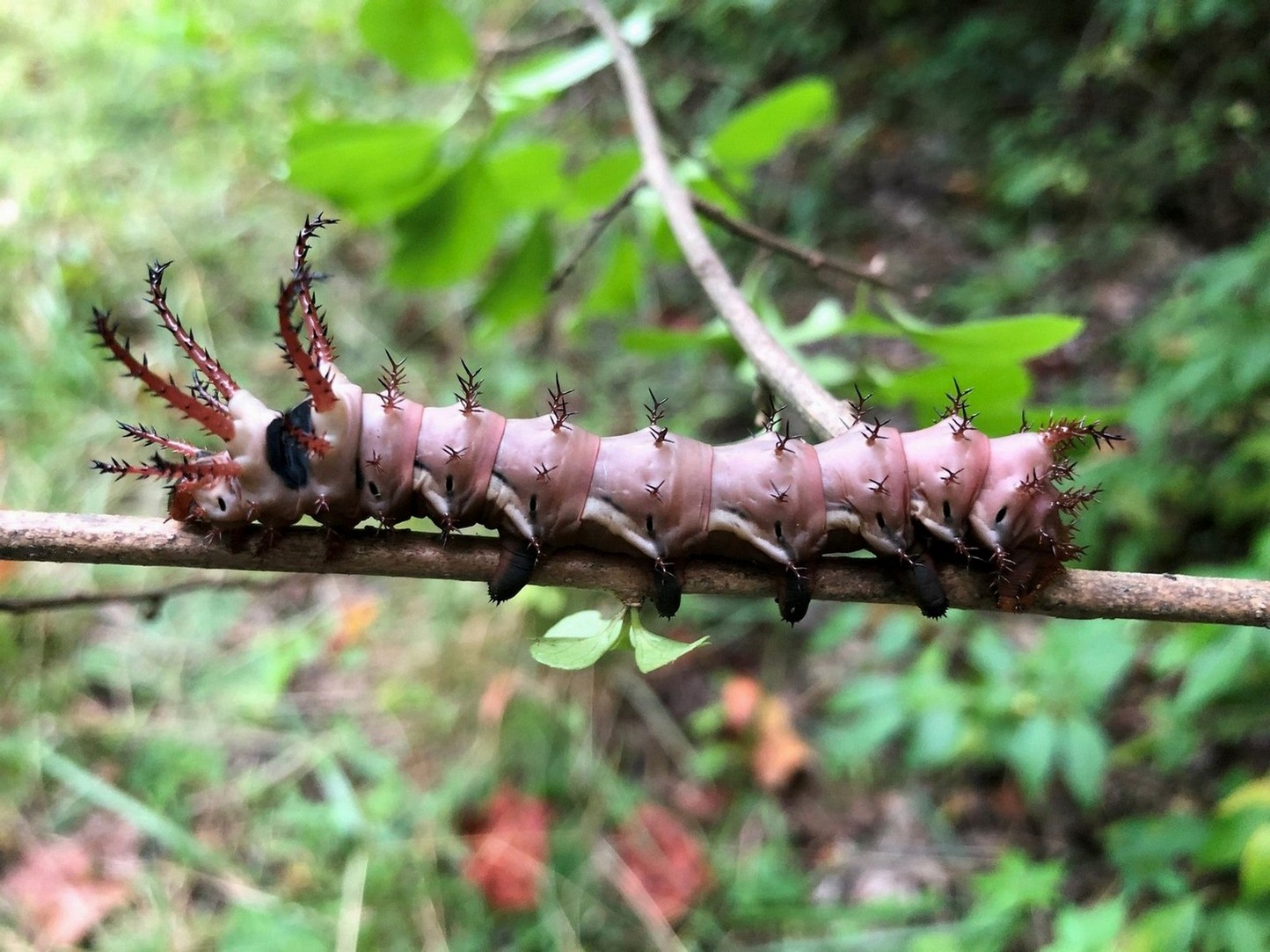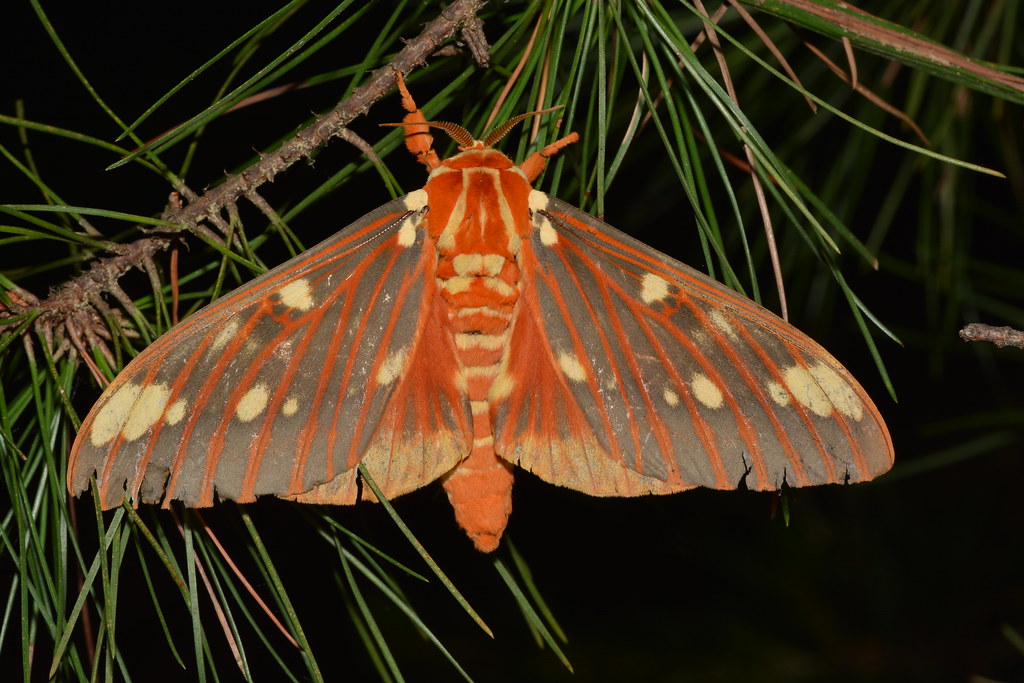Polk County’s Most Wanted – Hickory Horned Devil (Citheronia regalis)
Have you seen a Hickory Horned Devil (Citheronia regalis)?

Conserving Carolina and botanist/ecologist David Campbell need your help in locating this month’s “Polk County’s Most Wanted—Animal,” the Hickory Horned Devil (Citheronia regalis). Polk County’s Most Wanted is a community science initiative with a new challenge each month, in which you can expand the scientific understanding of the flora and fauna of Polk County.
This month’s Polk County’s Most Wanted is inspired by a recent encounter in the field. The Hickory Horned Devil is the name given to the larval (caterpillar) stage of the Regal or Royal Walnut Moth. This species is the largest caterpillar in the United States!
What is the life cycle of the Regal Moth and how do I identify the caterpillar and moth?
During development, from egg to moth, this caterpillar will go through several stages of growth and its appearance will change throughout each instar (a developmental stage of an arthropod between molts). The caterpillar encountered in the field was a striking brown color with small black, tan, then orange stripes along the sides and in each segment. It was about two inches in length and had about eight long, orange, black-spiny projections near its head, somewhat like a bottle brush, followed by shorter spiny projections running down the length of its body. It was later learned that this is what the Hickory Horned Devil looks like during its third and fourth instar. There is a related species of moth whose larval form looks very much like the above-mentioned stage of development of the Hickory Horned Devil, it is called the Pine Devil (Citheronia sepulcralis) and it has more stipes on the body and utilizes a slightly different habitat.

When in its final instar and before pupation, the mature Hickory Horned Devil caterpillar reaches nearly 6 inches in size! The fully-grown caterpillar has a fierce appearance, but it is harmless. Mature caterpillars can vary slightly in color but are commonly greenish blue with an orange head. Besides its large size, the most striking (and menacing) structures on this caterpillar are the long orange and black-tipped projections, sometimes up to ¾ of an inch long, on the second and third segments near the head. These long, orange projections are followed by short, spiny-looking black projections that run the length of the body.
Once the caterpillar reaches maturity, it makes its way to the soil, burrows in, and makes a subterranean cell where it molts into the pupal stage. The cylindrical pupa is about two inches in length, shiny, and dark brown. It remains in this pupal stage until the following summer when it emerges in its adult form, the Regal Moth. Regal Moths are large, with a wingspan of up to six inches. They a have stout orange-red body with yellow markings. The wings are a dull gray with red-orange wing veins and a few light, creamy-yellow oval spots.

Regal Moths emerge from their pupal stage with no mouth parts, their sole purpose is to find a mate and produce offspring. Adult moths live for about 10 days and subsist on stored nutrients left over from their larval stage. Like most moths, the Regal Moth is nocturnal. Adults emerge from May through mid-September, late in the evening, and they mate the following night. Females begin laying eggs at dusk on the third evening. Regal Moths produce one generation per year. Eggs hatch within 6-10 days. The larval stage is about 35 days, and the larvae can be seen from July to October.
Where should I look for the Hickory Horned Devil?
The regal moth is found in deciduous forest throughout the eastern United States, from New York to Missouri and southward to eastern Texas and central Florida. Larval host trees include Black Walnut (Juglans nigra), Butternut or White Walnut (Juglans cinerea), a variety of hickories (Carya spp.), including Pecan (Carya illinoinensis), Persimmon (Diospyros virginiana), Sweetgum (Liquidambar styraciflua), and sumacs (Rhus spp.).
Do Hickory Horned Devils have any natural predators?
Despite their large and foreboding appearance, Hickory Horned Devils are fairly rare. Birds are fond of them for food and parasites and diseases are responsible for killing a portion of the population as well. Consequently, very few of the hundreds of eggs laid by Regal Moths successfully develop and produce offspring of their own.
What can you do?
If you think that you have seen a Hickory Horned Devil or Regal Moth in Polk County, please contact Pam Torlina at [email protected] and, if possible, provide a clear image for evaluation.
For More Information
Visit Conserving Carolina’s website, conservingcarolina.org/polk-most-wanted, for more information about “Polk County’s Most Wanted” and to download and print a “Pocket Guide” with all of the “Most Wanted” plants, animals, and habitats that you can be on the lookout for!
Also, a culmination of David Campbell’s seven years in the field documenting the rare and significant flora and fauna in Polk County have been compiled in a book titled, “An Inventory of the Significant Natural Areas of Polk County, North Carolina.” The document can be downloaded for free on Conserving Carolina’s website at conservingcarolina.org/polk-county-inventory, or a hard copy can be purchased, at cost, on Amazon.
Conserving Carolina, your local land trust, is dedicated to protecting land and water, promoting good stewardship, and creating opportunities for people to enjoy nature. Learn more and become a member at conservingcarolina.org.